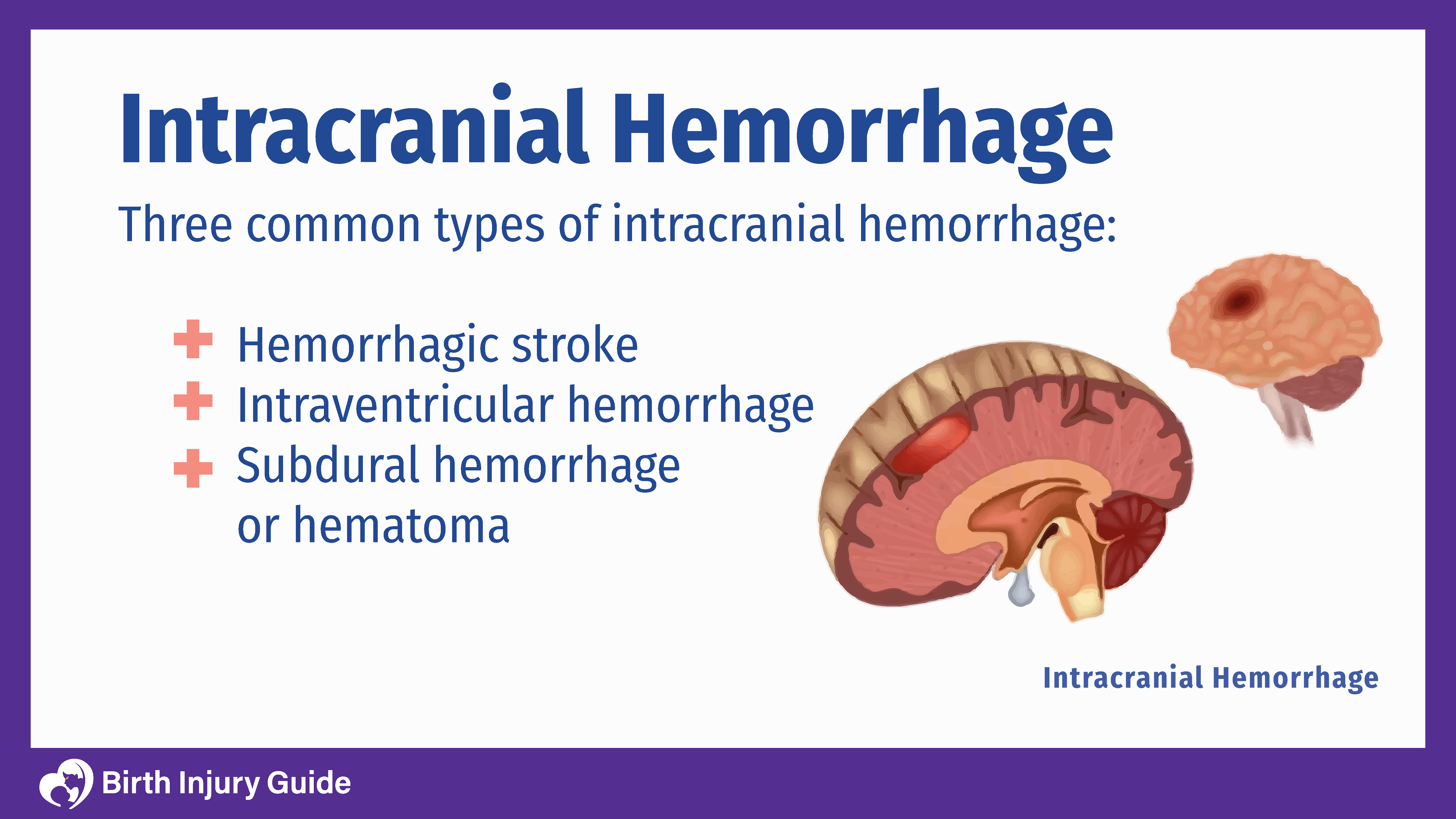
Intracranial Hemorrhage
Birth injuries can range from mild to severe, depending on the type of injury and what part of the baby’s body is affected. An infant brain bleed, better known as a brain hemorrhage or intracranial hemorrhage, is a type of disorder that can be caused by a birth injury. These injuries must be treated immediately to ensure the best possible outcome.
What is an Intracranial Hemorrhage?
An intracranial hemorrhage is a name for a severe kind of bleeding in the brain.

- Hemorrhagic Stroke: Occurs when a blood vessel ruptures. This causes bleeding in the brain that deprives the brain of oxygen and nutrition. A hemorrhagic stroke may be classified as intracerebral or subarachnoid.
- Intraventricular Hemorrhage: Most often occurs in premature infants or those with low birth weight. Because blood vessels do not fully develop before delivery, they are weaker and can rupture into the ventricular system of the brain.
- Subdural Hemorrhage or Hematoma: Occurs when blood vessels in the subdural space rupture. This area is between the arachnoid membranes and the dura, which allows compression of brain tissue. This most often is caused by traumatic injuries.
What Causes Intracranial Hemorrhage?
Brain hemorrhages can happen to anyone at any time. Typical causes of brain hemorrhages include:
- Head trauma
- Hypoxic insult at birth
- High blood pressure
- Aneurysm
- Blood vessel abnormalities
- Amyloid angiopathy (abnormal blood vessels usually plaguing older patients)
- Blood disorders
- Brain tumors
If your infant has a brain hemorrhage due to a birth injury, it may have been due to medical negligence or birth trauma. For example, if the baby was dropped just after delivery, or if there was blunt force trauma to the pregnant belly or to the newborn’s head. Blood pressure irregularities during birth can also contribute to fragile vessel hemorrhaging.
Although rare, the use of birth-assisted tools during delivery can lead to hemorrhaging. An infant’s head and skull are extremely fragile. Physicians must ensure that they properly use tools such as forceps or a vacuum extraction tool. Improper and/or forceful pulling when using the tools can create damage to the baby’s brain that can last a lifetime.
Start Your FREE Case Review Today
If you or your child is injured as a result of medical negligence, call us to learn more.
Can a Hemorrhage Be Prevented?
Unless your baby is the victim of a rare genetic mutation that involves abnormal brain cells, is very premature or has a blood disease, it is possible that birth trauma or medical negligence is the cause of your infant’s injury. If the brain hemorrhage happened due to blunt force trauma or any related medical mistake, it can almost always be prevented.
There are also some risk factors for intracranial hemorrhages that should be discussed with your healthcare team during pregnancy, labor and delivery. These risks factors include:
- Macrosomia
- Cephalopelvic disproportion
- Abnormal fetal presentation
- Prolonged labor
- Hypoxic-ischemic encephalopathy (HIE)
Symptoms of an Intracranial Hemorrhage
Sometimes it’s easier to assess the symptoms of a brain hemorrhage in an adult than it is to an infant. Some adults may express a problem with dizziness, difficulty speaking, changes in vision or a severe headache. Infants can’t communicate symptoms like that. What you can look for, however, are birth injury symptoms, such as:
- Difficulty swallowing or sucking
- Lethargy
- Loss of consciousness
- Nausea or vomiting
- Difficulty feeding
- Irritability
- Weakness in an arm or leg
- Seizures
Tests to Confirm Intracranial Hemorrhage Diagnosis
If your child’s doctor suspects that he or she has an intracranial hemorrhage, there are some tests that can help confirm their suspicions. Generally, tests performed to confirm bleeding within the skull include computed tomography (CT scan) and magnetic resonance imaging (MRI).
- CT Scan: CT scans use x-rays and specialized computer software to develop detailed pictures of the inside of the baby’s brain.
- MRI: MRIs use magnetic waves to develop very detailed images of the brain.
Both of these testing methods can provide medical imaging for the brain and blood vessels. In some cases, doctors may also perform an ultrasound of the infant’s head.
Treatment for Intracranial Hemorrhage
An intracranial hemorrhage can sometimes be treated through supportive means. This is most common in minor bleeds that are not likely to cause permanent damage. More severe bleeding may require brain surgery. Surgery closes off the hemorrhage, stops the bleeding and keeps additional brain cells healthy. While no parent wants their infant to go into emergency brain surgery, your baby may die without it.
In addition to supportive care and possible surgery, your infant may also need therapies after the hemorrhage has healed. Severe intracranial hemorrhages can cause physical and mental impairments, such as cerebral palsy and developmental delays. Your doctor may recommend physical, occupational or speech therapies begin as soon as possible.
Intracranial Hemorrhage Prognosis
The prognosis for an intracranial hemorrhage depends on factors like the severity, other medical conditions, and how well your child responds to treatment. Intracranial hemorrhages are known to have some long-term effects, such as developmental, social and behavioral delays or problems. Children who have recovered from an intracranial hemorrhage are more likely to experience hearing impairment, lower IQs and lower test scores than their peers.
How to Optimize Your Child’s Prognosis
As a parent, you want your child to thrive and succeed. If your child has experienced a birth injury, you may have reasonable concerns about their future. The good news is that there are some things you can do as a parent to optimize your child’s prognosis. These include:
- Work closely with your child’s healthcare team to address any and all related conditions.
- Find out how you can support therapies and education at home.
- Remember that your child may experience lifelong effects due to a birth injury. Be prepared to offer support.
- If your child, or your family, is having a difficult time managing medical conditions, consider family counseling.
Parents are the front line of support for children with birth injuries. By exploring your child’s injury or illness and ways you can support them, you can help them have the best quality of life possible.



